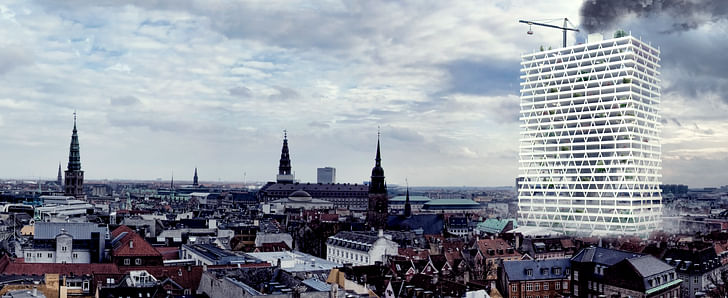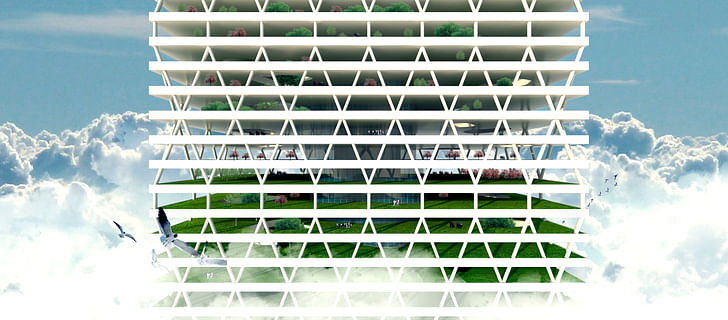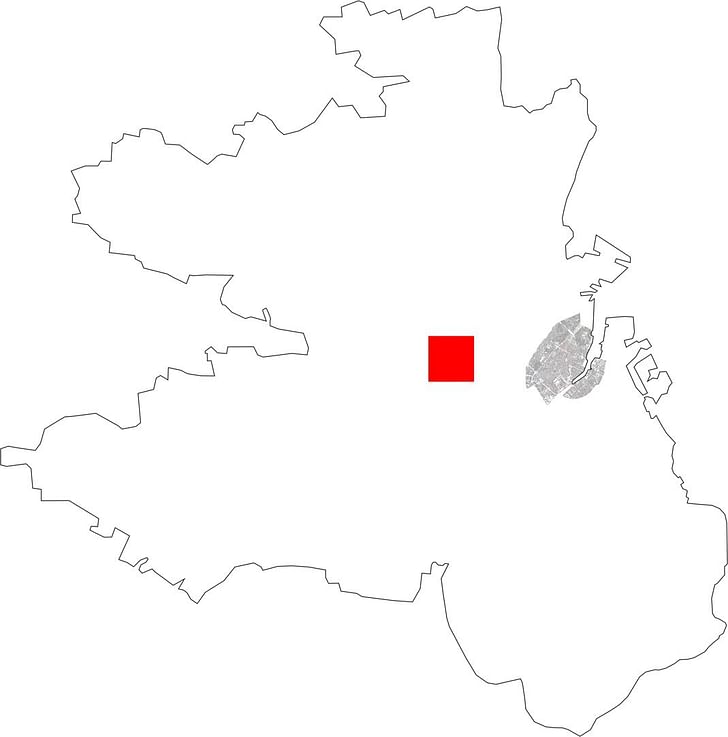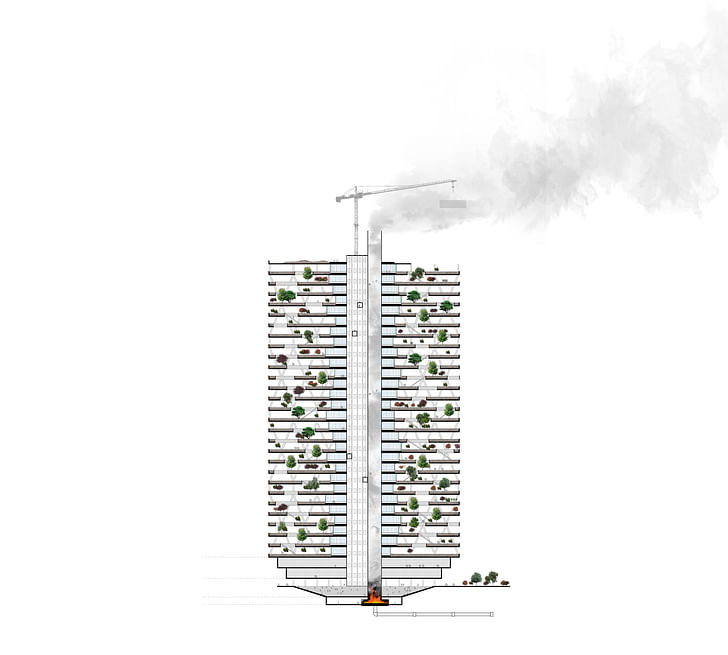

Martin McSherry’s “The Vertical Graveyards” is a speculative proposal for a new infrastructure of death, mimicking the skyscraper as a symbol of expanding and densifying urban systems. Currently an MArch student at the Royal Danish Academy of Fine Arts, McSherry initially drafted the project as a proposal to the Nordic Association for Graveyards and Crematoria’s “The Graveyards of the Future” competition. Imagining the cemetery as vertical and central, rather than horizontal and suburban, the project focuses less on design specifics and more on provoking a change in societal attitudes towards death.
While the competition took place in Oslo, McSherry’s renderings depict his “Vertical Graveyards” in central Copenhagen, and his presentation text is in Danish. McSherry’s complete project description is below.

THE VERTICAL GRAVEYARDS
The project was a result of a Scandinavian student competition called THE GRAVEYARDS OF THE FUTURE. The program of the competition featured a lot of idyllic photos of Norwegian cemeteries in beautiful surroundings such as mountains, forests and so on. I got the impression that they were not really looking for change or original ideas but rather subtle landscape proposals. So I actually felt a bit provoked to do something a bit radical.
By addressing global issues such as over population and scarce land (problems which are not felt in Norway or Scandinavia for that matter) I came up with the tower which I thought might start a more interesting discussion than if I did a minimalistic garden project.
I was surprised to receive a prize for the project since there are obviously elements which are rather humorous. Luckily for me, the Norwegians have a bit of humor.
An important question for me when doing the project was how can I make death visible in our society? Initially, I was thinking of exposing dead bodies in the urban space but I quickly left that thought and replaced it with the visible smoke from the chimneys of the crematorium.
The project is clearly conceptual and therefore there are no drawings that go into the design in detail, as it is only there to demonstrate an idea.

URBAN LACK OF SPACE
In the beginning of the 19th century the metropolises were facing problems with overfilled cemeteries, which they solved by no longer only allowing burial sites to be limited by the sacred grounds of the churches. Now 200 years later, the question of capacity arises once again: 7 billion people inhabit this planet of which 50% live in the big cities, in the year 1900 this number was only 14% and in 2050 it is expected to be 70%.
The number of inhabitants in Copenhagen is growing annually by 10-14% and the city is struggling with supplying enough housing for everyone.
THE REJECTION OF POSTMODERNISM
The 20th century brought along a transfer of practices concerning death from the homes to the public institutions, such as retirement homes and hospitals. These institutions now alone had the knowledge and experience of witnessing death which before used to belong to the family and the rest of society. This transfer has meant a rising alienation of death in our society, which consequently has created a repressing of death. This is expressed in our increasing number of cremations and wishes of anonymous graves. Today death seems to be an immovable taboo which we prefer to hide away. Functionalism was denied access to the cemeteries, which today exists in our cities as urban voids, forgotten by development. The architecture is left incapable of showing the function which it performs, simply because we find it inappropriate. Death is hidden away so we do not need to deal with or even think of it. Instead it should be presented in our everyday lives as the natural phenomenon it is – an inevitable part of life.


THE VERTICAL GRAVEYARDS
For 3,800 years the tallest building in the world was a grave, the pyramids of Giza are the oldest skyscraper necropolises and are from a time when one would prepare for death all throughout life, the opposite of today where we’d rather avoid talking about it.
This project suggests a skyscraper necropolis which gradually replaces all cemeteries in Copenhagen as it grows in height. The existing burial grounds around the city will be demolished and replaced by areas for the living souls of Copenhagen. The vertical graveyards will, with its open facades and green vegetation, become a significant object in the townscape and a daily reminder of death. With time it will be the tallest building in the city – the city’s ever changing monument.


INDIVIDUALISATION
Everywhere in society we see individualization on the march. Before it was about being ”normal”, today it’s about being special. Before, it was fine to get what the neighbor has got but now it has to be something which adds to our self-portrait. From standard to unique, standardized mass production is gradually on its way out and is being replaced by individually adapted products. This tendency is reflected in our creation of the personal religion. We move away from a common starting point; Christianity represented by the National church. An individualization of belief is happening, we pick up bits and pieces from the established religions as if it was a big “help yourself table” and put them together in our own ways. From the collective to the individual. To the great majority the National church is becoming irrelevant. Still, most people have a personal god, believe in a spiritual energy, or they are in doubt. There is a spiritual need, but it is no longer sought within the walls of the church. This can also be read in the rising need for a more personal departure with our closest ones, and the staging of our own farewell to life.
Combined with a still more religiously diverse society, individualization means that there is a need for openness and flexibility when discussing how to conduct our death ceremonies and burial sites.

STRUCTURE
With its many different floors THE VERTICAL GRAVEYARDS take into account the many different requirements: Tendencies in society within the field of burial ceremonies will dictate the design of each floor, which is then tailored to the exact contemporary need. In this way, the tower will reflect present society on its top floors and the past as you move downwards.
More than 90% of Copenhageners choose cremation and the number is rising. In connection to this, the base of the tower is a crematorium in the basement, while the core is a massive chimney rising from the crematorium's many ovens. Excess heat from the ovens is connected to the city’s district heating system, and thereby works as an important heating resource to the many households.

THE MEMORIAL
Name and date is carved into stone and then placed on the grave. This is what we did before the arrival of Christianity and this is what we still do. Out of date barely describes this routine. In its physical form and materiality, the gravestone is dead but eternal, seen in the light of history, it seems an obvious choice as a memorial designed to withstand hard weather and the ravages of time. But seen in a contemporary light, this tradition seems rather ridiculous since “the eternal memorial” is removed already after a period which can be only 10 years. At the same time we might ask ourselves if a stone carrying our name and a few dates is really what we want as a witness of our existence in this world? The replacement seems obvious: Actually most of us work daily on documenting and communicating our everyday existence, unconsciously we are creating the ultimate memorial. In a few decades from today, the internet will contain millions of life stories, from MySpace to Facebook, to Twitter, to Tumblr, to everything which is still to come. We will be able to trace the entire life of a person from birth to death through the thousands of posts and pictured uploaded by that very person or their friends. This sharing of all aspects of life, from the biggest moments to the most mundane routines, will eventually mean that the social networks will replace the cemetery as the place where the dead are remembered.
Former Managing Editor and Podcast Co-Producer for Archinect. I write, go to the movies, walk around and listen to the radio. My interests revolve around cognitive urban theory, psycholinguistics and food.Currently freelancing. Be in touch through longhyphen@gmail.com
No Comments
Block this user
Are you sure you want to block this user and hide all related comments throughout the site?
Archinect
This is your first comment on Archinect. Your comment will be visible once approved.